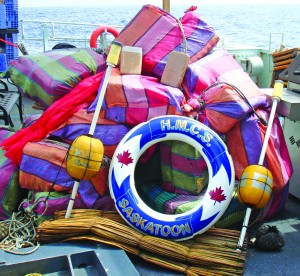Perseverance pays off; How Saskatoon seized drugs
By Lookout on Apr 25, 2016 with Comments 0

Photos Op Caribbe
A crewmember from HMCS Saskatoon and members of the United States Coast Guard Law Enforcement Detachment secure the seized cocaine bales.
Lt(N) Linda Coleman, Op Caribbe, Public Affairs Officer ~
It was a hot and humid day in the eastern Pacific Ocean on March 25 as HMCS Saskatoon and its embarked United States Coast Guard (USCG) Law Enforcement Detachment (LEDET) conducted patrols during Operation Caribbe, Canada’s contribution to the multinational campaign against the trafficking of illicit narcotics.
It was a sticky 35 degrees Celsius and the inside of Saskatoon was buzzing with activity.
The ship received information from the U.S. Joint Interagency Task Force (South) that a U.S. Maritime Patrol Aircraft (MPA) had spotted a vessel of interest in the area of operations.
All shipboard specialists began to work together; the integration of the LEDET with Saskatoon’s operations team was seamless.
A positive picture began to develop over the day.
The coordinates of the vessel of interest that had been spotted by the MPA were relayed to Saskatoon, and the Commanding Officer, Lieutenant-Commander Todd Bacon, made the order to proceed at operational speed on an intercept course towards the vessel.
As the MPA patrolled the area the vessel being monitored, a “panga”-style fishing boat, began to jettison its cargo—a common occurrence throughout Operation Caribbe.
The eastern Pacific Ocean is a known drug trafficking area for small boats, often fitted with multiple outboard motors. Saskatoon then prepared for the next phase of this particular tasking.
What started off as a “detect, track, approach and intercept” tasking quickly turned into a search and recovery mission.
The MPA reported the last known position of the debris field, which would turn out to contain 16 bales of illicit narcotics, and Saskatoon went into search mode.
By this point, it was evening and the MPA had returned to base. Once Saskatoon arrived at the last known position of the jettison field, search lights came on and crew members grabbed night vision binoculars.
“You need to treat this no differently than any other search and rescue,” said LCdr Jason Bergen, the Executive Officer.
“If we don’t find the jettison field, the illicit narcotics risk being picked up by traffickers and eventually distributed on the streets of North America.”
The ship’s company and the LEDET team worked together throughout the night. The temperature dropped to a more tolerable level and the moon came out, providing just enough light.
The bridge doors stayed open to accommodate the flow of people in and out, and the upper decks had crew members of all trades acting as lookouts searching for bales of drugs.
The lookout positions were rotated every 20 minutes. “It’s a huge strain on your eyes looking through night vision binoculars for a long period of time,” said a crew member of Saskatoon.
“So we’re taking turns rotating between scanning the ocean with search lights and using the night vision binoculars.” As the night went on, staying positive and focused became a challenge.
At 3 a.m., a Master Seaman Boatswain brought up popsicles for those on watch to boost morale. It was a refreshing treat for those working in the heat and humidity.
“It’s the little things that count,” said the Boatswain, who followed up with fruit, freshly-baked croissants and coffee at 6 a.m. By first light on March 26, the MPA returned to provide assistance.
It sighted the debris field and marked it with a smoke flare. Saskatoon and its crew approached the field with relief and excitement, as their efforts were finally fulfilled.
Saskatoon’s Rigid Hull Inflatable Boat with members of the LEDET team was launched and the bales were retrieved from the water with the help of Saskatoon’s crane and a cargo net.
Within minutes, the LEDET team tested and confirmed that the substance found within the bales was cocaine. “It was all hands on deck for this seizure and I am proud of the dedication and commitment displayed by the ship’s company,” said LCdr Bacon.
“This recent success showcases the team’s resolve and their ability to work as a cohesive unit to suppress criminal activity in the region.”
After searching an area of approximately 120 square miles for more than 12 hours, Saskatoon and its embarked LEDET seized 16 bales of cocaine weighing a total of 640 kg.
Filed Under: Top Stories
About the Author:





